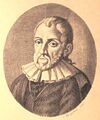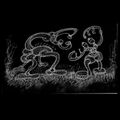Template:Selected anniversaries/October 2: Difference between revisions
No edit summary |
No edit summary |
||
| Line 20: | Line 20: | ||
File:François Arago.jpg|link=François Arago (nonfiction)|1853: Mathematician and politician [[François Arago (nonfiction)|François Arago]] born. He observed that a rotating plate of copper tends to communicate its motion to a magnetic needle suspended over it, an effect now known as eddy current. | File:François Arago.jpg|link=François Arago (nonfiction)|1853: Mathematician and politician [[François Arago (nonfiction)|François Arago]] born. He observed that a rotating plate of copper tends to communicate its motion to a magnetic needle suspended over it, an effect now known as eddy current. | ||
||1883 | ||1883: Karl von Terzaghi born ... geologist and engineer. | ||
File:Édouard Lucas.png|link=Édouard Lucas (nonfiction)|1890: Mathematician and crime-fighter [[Édouard Lucas (nonfiction)|Édouard Lucas]] translates the Fibonacci sequence into a series of [[Gnomon algorithm functions]] which will quickly find application in the detection and prevention of [[crimes against mathematical constants]]. | File:Édouard Lucas.png|link=Édouard Lucas (nonfiction)|1890: Mathematician and crime-fighter [[Édouard Lucas (nonfiction)|Édouard Lucas]] translates the Fibonacci sequence into a series of [[Gnomon algorithm functions]] which will quickly find application in the detection and prevention of [[crimes against mathematical constants]]. | ||
||Charles Stark "Doc" Draper | ||1901: Charles Stark "Doc" Draper born ... scientist and engineer, known as the "father of inertial navigation". He was the founder and director of the Massachusetts Institute of Technology's Instrumentation Laboratory, later renamed the Charles Stark Draper Laboratory, which made the Apollo Moon landings possible through the Apollo Guidance Computer it designed for NASA. | ||
||Willy Otto Oskar Ley | ||1906: Willy Otto Oskar Ley born ... science writer, spaceflight advocate, and historian of science who helped to popularize rocketry, spaceflight, and natural history in both Germany and the United States. | ||
||1907 | ||1907: Alexander R. Todd born ... biochemist and academic, Nobel Prize laureate. | ||
||1909 | ||1909: Alex Raymond born ... cartoonist, creator of Flash Gordon. | ||
||1914 | ||1914: Jack Parsons born ... chemist, occultist, and engineer. | ||
||1917 | ||1917: Christian de Duve born ... cytologist and biochemist, Nobel Prize laureate. | ||
||1921 | ||1921: Albert Scott Crossfield born ... pilot and engineer. | ||
||1925 | File:John Logie Baird 1917.jpg|link=John Logie Baird (nonfiction)|1925: [[John Logie Baird (nonfiction)|John Logie Baird]] performs the first test of a working television system. | ||
|| | ||1926: Michio Suzuki born ... mathematician who studied group theory. Pic search: https://www.google.com/search?q=Michio+Suzuki | ||
|| | ||1927: Svante Arrhenius born ... physicist and chemist, Nobel Prize laureate. | ||
|| | ||1933: John Gurdon born ... biologist and academic, Nobel Prize laureate. | ||
||1950 | ||1947: P. D. Ouspensky dies ... mathematician and philosopher. | ||
||1950: Peanuts by Charles M. Schulz is first published. | |||
File:ENIAC.jpg|link=ENIAC (nonfiction)|1955: [[ENIAC (nonfiction)|ENIAC]] retired. After disassembly, parts of the Electronic Numerical Integrator and Computer, the first general purpose electronic computer, were shipped to the Smithsonian for display. | File:ENIAC.jpg|link=ENIAC (nonfiction)|1955: [[ENIAC (nonfiction)|ENIAC]] retired. After disassembly, parts of the Electronic Numerical Integrator and Computer, the first general purpose electronic computer, were shipped to the Smithsonian for display. | ||
||1959 | ||1959: The anthology series The Twilight Zone premieres on CBS television. | ||
||1962 | ||1962: Boris Yakovlevich Bukreev dies ... mathematician and author. | ||
File:John Crank.jpg|link=John Crank (nonfiction)|1963: Mathematician, physicist, and crime-fighter [[John Crank (nonfiction)|John Crank]] uses the Crank–Nicolson method to detect and prevent [[crimes against mathematical constants]]. | File:John Crank.jpg|link=John Crank (nonfiction)|1963: Mathematician, physicist, and crime-fighter [[John Crank (nonfiction)|John Crank]] uses the Crank–Nicolson method to detect and prevent [[crimes against mathematical constants]]. | ||
||Hans Jacob Reissner | ||1967: Hans Jacob Reissner dies ... aeronautical engineer whose avocation was mathematical physics. He solved Einstein's equation for the metric of a charged point mass. His Reissner–Nordström metric demonstrated that an electron has a naked singularity rather that an event horizon. | ||
||Beniamino Segre | ||1977: Beniamino Segre dies ... mathematician who is remembered today as a major contributor to algebraic geometry and one of the founders of finite geometry. Pic. | ||
||1996 | ||1996: The Electronic Freedom of Information Act Amendments are signed by U.S. President Bill Clinton. | ||
||Olin Jeuck Eggen | ||1998: Olin Jeuck Eggen dies ... astronomer. He became known as one of the best observational astronomers of his time. He will be the first to introduce the now-accepted notion of moving groups of stars, and co-author of a seminal 1962 paper which suggests for the first time that the Milky Way Galaxy had collapsed out of a gas cloud. Pic. | ||
||Tosio Kato | ||1999: Tosio Kato dies ... mathematician who worked with partial differential equations, mathematical physics and functional analysis. | ||
||2002 | ||2002: Heinz von Foerster born ... physicist and philosopher. | ||
File:Paul Halmos.jpg|link=Paul Halmos (nonfiction)|2006: Mathematician and academic [[Paul Halmos (nonfiction)|Paul Halmos]] dies. He made fundamental advances in the areas of mathematical logic, probability theory, statistics, operator theory, ergodic theory, and functional analysis (in particular, Hilbert spaces). | File:Paul Halmos.jpg|link=Paul Halmos (nonfiction)|2006: Mathematician and academic [[Paul Halmos (nonfiction)|Paul Halmos]] dies. He made fundamental advances in the areas of mathematical logic, probability theory, statistics, operator theory, ergodic theory, and functional analysis (in particular, Hilbert spaces). | ||
Revision as of 17:46, 17 January 2019
1588: Philosopher and scientist Bernardino Telesio dies. While his natural theories were later disproven, his emphasis on observation influenced the emergence of the scientific method.
1589: Physician, archaeologist, and crime-fighter Michele Mercati publishes study of prehistoric stone tools, including evidence of prehistoric crimes against mathematical constants.
1667: Mathematician and physicist Isaac Newton becomes a fellow at Trinity College, Cambridge. He had earned his bachelor's degree in 1665 and then spent two years at home in Lincolnshire inventing much of differential and integral calculus while Cambridge was closed due to plague.
1853: Mathematician and politician François Arago born. He observed that a rotating plate of copper tends to communicate its motion to a magnetic needle suspended over it, an effect now known as eddy current.
1890: Mathematician and crime-fighter Édouard Lucas translates the Fibonacci sequence into a series of Gnomon algorithm functions which will quickly find application in the detection and prevention of crimes against mathematical constants.
1925: John Logie Baird performs the first test of a working television system.
1955: ENIAC retired. After disassembly, parts of the Electronic Numerical Integrator and Computer, the first general purpose electronic computer, were shipped to the Smithsonian for display.
1963: Mathematician, physicist, and crime-fighter John Crank uses the Crank–Nicolson method to detect and prevent crimes against mathematical constants.
2006: Mathematician and academic Paul Halmos dies. He made fundamental advances in the areas of mathematical logic, probability theory, statistics, operator theory, ergodic theory, and functional analysis (in particular, Hilbert spaces).
2007: Signed first edition of The Safe-Cracker provides clues which lead to the arrest and imprisonment of math criminals.
Two Bugs Fighting voted Picture of the Day by the citizens of New Minneapolis, Canada.










